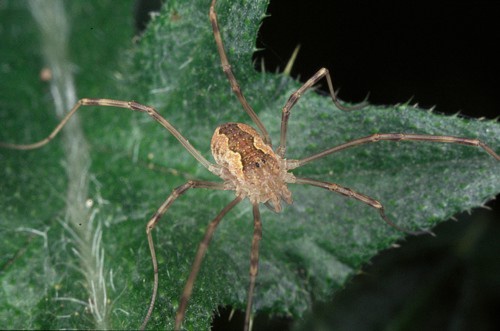A recent addition to the fauna of the Rhynie chert are harvestmen ('daddy long-legs').
These spider-like arachnids belong to the order Opiliones, and are primarily distinguished from other arachnids by the lack of a distinct division between the head and body, and the opisthosoma is segmented. Many are easily recognisable by their small ovoid bodies and long legs, hence their common name 'daddy long-legs' (see inset below). The order name comes from the Latin opilio, meaning shepherd, and may derive from the elevated position of the body on the long slender legs or the fact that male harvestmen guard the female during egg laying. Today harvestmen are a common and widespread group and tend to live in cool, damp terrestrial habitats such as in plant litter or wetland.

- Fossil Record
-
As with other arachnids, and indeed other terrestrial arthropods with un-mineralised exoskeletons, harvestmen are generally rare in the fossil record.
A few Palaeozoic and Mesozoic examples are known, such as from the Lower Carboniferous of Scotland (e.g. Wood et al. 1985 ); but most fossils have been found in rocks of Tertiary age, particularly the Florissant Formation of Colorado, USA (e.g. Cokendolpher & Cokendolpher 1982 ), and from Baltic, Dominican and Bitterfeld ambers (e.g. Cokendolpher & Poinar Jr 1998 ; Dunlop & Giribet 2003 ). Three specimens of fossil harvestmen have recently been discovered in the Rhynie chert (two male and one female), and have attracted much interest, not only because they represent the earliest known harvestmen in the fossil record but also because they contain the silicified remains of the earliest known preserved genitalia of a terrestrial animal ( Dunlop et al. 2003 ).
A formal description and diagnosis for the Rhynie chert harvestmen has been written by Jason Dunlop and other authors ( Dunlop et al. 2004 ). These authors believe the fossil specimens represent a single species, to which they have assigned the name Eophalangium sheari.
- Morphology
-
The Rhynie chert harvestmen are fairly small. The female specimen has a body length of approximately 6mm; the males are somewhat smaller with an opisthosoma length of approximately 1.2mm (see insets below). The female specimen exhibits a well developed median eye tubercle, and one of the male specimens possesses the distinctive long slender legs seen in many extant harvestmen (with the exception of the Cyphopthalmi) (see inset below). The specimens are essentially 'modern' in their appearance, particularly with regards to the morphology of the penis and ovipositor (see insets below).


The ovipositor within the opisthosoma of the female appears distinctly annulated (see inset below) and exhibits numerous short sensory setae, and together with the presence of long legs is particularly reminiscent of a particular modern harvestman clade, the Eupnoi. This suggests the Rhynie fossils are either representatives of the eupnoid group of harvestmen or an extinct sister taxon, either way they are unequivocally members of the harvestman crown-group.


The female harvestman fossil exhibits other internal structures within the opisthosoma, as well as the ovipositor. These include a gut trace, its content comprising mainly dark brown-coloured amorphous organic matter (see inset above); and the respiratory structures (see inset below). The respiratory structures, the trachea, comprise a series of cuticular tubes originating from the ventral surface of the anterior opisthosoma, directly behind the fourth leg coxae. Their position and morphology are almost identical to those seen in modern harvestmen ( Dunlop et al. 2003 ) and indicate the animal was definitely a fully terrestrial organism.

- Palaeoecology
-
Extant harvestmen are omnivorous. They generally feed on dead plant and animal matter (saprovorous) but will also kill small arthropods and invertebrates. Harvestmen lack silk-producing spinnerets and therefore do not spin webs to catch their prey. They also eat faecal matter and organic detritus (detritivores) and fungi. Eophalangium sheari probably had a similar diet.
The well developed branching trachea in Eophalangium sheari indicates the Rhynie harvestmen, like their modern counterparts, were unequivocally terrestrial animals; and is the earliest known example of this type of air-breathing apparatus in arachnids. The tubular respiratory organs in opilionids is quite different, for example, from the lamellate book lungs seen in true spiders and the extinct trigonotarbids . Since arachnids (along with all animal groups) began life in the sea, the marked differences in 'lung' morphology indicates their terrestrialisation did not occur as a single event, their different respiratory systems evolving independently of each other.
The possession of a 'penis' is an adaptation required for sperm transfer on land. Normally sperm would rapidly dry out in a terrestrial environment, but being able to transfer sperm directly into the female overcomes this problem. Like modern harvestmen, during egg laying the Early Devonian female harvestman would have extended its ovipositor and 'injected' its eggs directly into damp soil or plant litter. Clearly the reproductive behaviour seen in modern harvestmen was well established by the Early Devonian.
